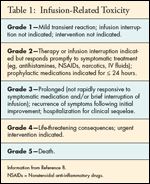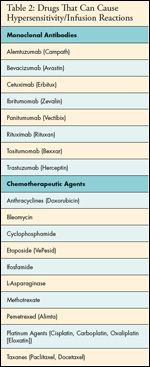An Infusion Reaction to Cetuximab
Hypersensitivity/infusion reactions can be caused by monoclonal antibodies and chemotherapeutic agents. Immediate interventions are often required.
The patient, “DJ,” is a 53-year-old Hispanic male who sought medical attention for persistent fullness and discomfort in the right submandibular region. Imaging studies, which included a CT scan of the head and neck, revealed a 2-cm right tonsillar lesion, and lymph node involvement. A PET/CT scan showed intense hypermetabolic activity in the right tonsil, and a large necrotic right lymph node (level 2). No other areas of hypermetabolic activity were noted. A CT-guided biopsy of DJ’s right tonsillar lesion was performed, and the pathology was positive for squamous cell carcinoma.

The patient experienced a mild infusion reaction during a cetuximab infusion to treat his tonsillar tumor. Cetuximab was stopped and normal saline was infused. He was given oxygen via nasal cannula; acetaminophen (for his fever); and, to reduce his itching, rash, shortness-of-breath, and hypotension, he was given epinephrine, diphenhydramine, and hydrocortisone. Nurses need to document in the patient record when infusion reactions occur, how much drug was infused, the patient’s signs and symptoms, and the medications given to treat the reaction.
DJ was then referred to a head and neck surgeon, who decided that surgery would not be his best treatment option; therefore, DJ was then evaluated by both a medical and a radiation oncologist. The medical and radiation oncologists recommended that DJ receive concurrent treatment with the monoclonal antibody cetuximab (Erbitux) and radiation therapy. DJ is coming to the treatment center to begin his treatment regimen. He is to receive cetuximab at a loading dose of 400 mg/m2, followed by weekly cetuximab with daily radiation therapy for 7 weeks.
After the premedications are administered, the cetuximab infusion is started. DJ’s vital signs are stable, he has no complaints, and he feels well. Thirty minutes into the infusion, DJ calls the nurse. He is complaining of shortness-of-breath, itching, hives on his arms, nausea, and low back pain. In addition, he has a fever. The cetuximab infusion is stopped, and IV normal saline is infused. Assessment of DJ shows that he has a patent airway, no stridor, urticaria, and is hypotensive, but he is awake, alert, and answers questions appropriately. DJ is having a mild hypersensitivity reaction to the cetuximab. The nurse notifies DJ’s medical oncologist and initiates her institution’s hypersensitivity reaction protocol.
Cetuximab
Cetuximab is a chimeric (containing both human and mouse sequences) monoclonal antibody.[1] It is approved by the US Food and Drug Administration (FDA), in combination with radiation therapy, for treatment of squamous cell carcinoma of the head and neck, and for recurrent metastatic disease after treatment with a platinum-based therapy.[2]
Cetuximab also is FDA-approved for treatment of colorectal cancer, as monotherapy for patients with epidermal growth factor receptor (EGFR)-expressing disease who have failed to respond to treatment with both oxaliplatin (Eloxatin) and irinotecan (Camptosar)-containing regimens, and in combination with irinotecan for patients whose tumors express EGFR and which are refractory to irinotecan-based therapy.[2]
Infusion Reactions
The immune system is always involved in infusion reactions.[3] Some are allergic in nature and are mediated by immunoglobulin E (IgE); these are called anaphylactic reactions.[4] Anaphylactoid reactions represent the majority of infusion reactions.[5] Anaphylactoid reactions are not IgE-mediated, involve partial hypersensitivity, and tend to be less life-threatening than anaphylactic reactions.[5]
Cytokine release causes most of the infusion reactions related to monoclonal antibodies.[6,7] Cytokines, such as interleukin, interferon, and tumor necrosis factor, are released into circulation after destruction of a targeted cell by either phagocytosis or cytolysis; this occurs when immune-effector cells (monocytes, macrophages, cytotoxic T cells, natural killer cells) bind to the Fc (fragment, crystallizable) region (the constant portion) of the antibody and target the cell for death. This process is initiated when a monoclonal antibody binds with an antigen on the targeted cell.[6]
TABLE 1

Infusion-Related Toxicity
Infusion reactions (anaphylactoid reactions) have signs and symptoms similar to those of hypersensitivity reactions (anaphylactic reactions), and both types of reactions are generally managed similarly.[3] While the incidence of associated reactions varies among the monoclonal antibodies, most reactions tend to occur during the first infusion.[3] Usually, the infusion reactions related to monoclonal antibodies are mild (grade 1 or 2), and the incidence of severe reactions (higher grade 3 or 4) tends to be low (see Table 1).[1]
Symptoms of Infusion Reactions
The signs and symptoms of an infusion reaction caused by monoclonal antibodies (cytokine-release syndrome) include: fever, shaking, chills, flushing, itching, changes in blood pressure, dyspnea, chest discomfort, back pain, nausea, vomiting, diarrhea, and skin rashes. Mild reactions are considered as grade 1 (transient flushing or rash, no fever) or grade 2 (flushing, uriticaria, rash, and fever). The mild reactions occur in perhaps 20% of patients, usually (but not always) during the first infusion. The symptoms of severe reactions, grade 3 or 4, include acute (or rapid) onset of bronchospasm, stridor, hoarseness, nausea, vomiting, urticaria, and/or hypotension. The severe symptoms are more consistent with anaphylaxis reactions, and 90% of these reactions occur with the first treatment.[1]

Management of Infusion Reactions
The management and interventions used to treat an infusion reaction are based upon the patient’s symptoms and status.[3] Step one is to stop the infusion. Then, assess the patient, checking the airway, breathing, and circulation (ABC). Normal saline should be infusing at a vigorous rate of 150 mL/hr, and oxygen should be administered to the patient via a nasal cannula. Vital signs should be checked and recorded every 2 to 5 minutes, and the patient’s level of consciousness should be assessed.[9]
Histamine antagonists (H1 and H2), such as diphenhyd-ramine and ranitidine, should be given for management of pruritis, urticaria, and angioedema.[9,10] Bronchodilators are used to treat bronchospasm; while corticosteroids may be given, as they may decrease the duration of a reaction or possibly prevent a biphasic (recurrent) reaction, corticosteroids do not work in the acute management of anaphylaxis.[9,10]
Epinephrine is considered the drug of choice to use in an anaphylactic reaction,[4] with dosing based on the severity of the reaction.[3] If the patient is hypotensive and is unresponsive to epinephrine (ie, the blood pressure does not increase), then a dopamine infusion may be started.[9]
Management of the Patient’s Infusion Reaction
To manage DJ’s infusion reaction, the cetuximab is stopped, and normal saline is infusing at 150 mL/hr. DJ is awake, with a patent airway, and is alert and oriented. He is given oxygen at 2 L/minute via nasal cannula, although his oxygen saturation is 96% on room air.
His pulse is somewhat elevated, at 102 beats/min, but his blood pressure has dropped to 94/52. DJ’s medical oncologist is called to report the reaction, and the nurse initiates the institution’s hypersensitivity orders. DJ is given acetaminophen at a single dose of 1,000-mg orally, for the fever. To reduce his itching, rash, shortness-of-breath, and hypotension, he is given epinephrine (1:1000) at 0.5 mL SC, diphenhydramine at 50 mg IV, and hydrocortisone at 100 mg IV. His infusion reaction is treated, and it resolves. Observation is continued, and he continues to have stable vital signs.
TABLE 2

Drugs That Can Cause Hypersensitivity /Infusion Reactions
After evaluating DJ, his medical oncologist determines that he can be re-treated with cetuximab, but at a slower infusion rate and with premedications, using antihistamines and corticosteroids. DJ is monitored very closely for the remainder of the infusion session, and he is then observed for 1 hour after the monoclonal antibody infusion is completed. He remains stable, without any respiratory complaints, and is deemed fit to go home.
Discussion
Hypersensitivity/infusion reactions may occur with various cancer treatments. They can happen in conjunction with therapy using monoclonal antibodies as well as with chemotherapeutic agents. The list of agents that can trigger these reactions is quite extensive (see Table 2). Patients who are about to begin treatment with a monoclonal antibody need a full physical assessment prior to initiating treatment.
Once the infusion begins, patients need to be monitored very closely, and particular attention should be paid to the airway and vital signs. Patients and family members need education about toxicity management and potential reactions (which happen usually, but not always, during the infusion). Hypersensitivity/infusion reactions can occur quickly, and immediate interventions are required.
The nurse needs to document in the patient’s chart/record if a reaction occurred, when it occurred, how much drug was infused, and the signs and symptoms of the reaction. The medications given to the patient for treatment of the reaction also need to be documented. Hypersensitivity/infusion reactions can be frightening for the patient and family, but with reassurance and patient/family education, some of this anxiety can be alleviated. It is also important to remember that, even following an infusion reaction, the patient may be able to continue receiving the monoclonal antibody, although he or she will also need to be given premedications such as antihistamines and corticosteroids, and the monoclonal antibody will need to be infused at a slower rate.
Financial Disclosure:The author has no significant financial interest or other relationship with the manufacturers of any products or providers of any service mentioned in this article.
References:
References
1. LaCasce AS, Castells MC, Bursetin H, et al: Infusion Reactions to Therapeutic Monoclonal Antibodies Used for Cancer Therapy. 2010. Available at, http://www.uptodate.com/contents/infusion-reactions-to-therapeutic-monoclonal-antibodies-used-for-cancer-therapy.
2. Erbitux® [Package Insert]. Bristol-Myers Squibb Co., 2010. Available at: http://www.packageinserts.bms.com/pi/pi_erbitux.pdf.
3. Vogel WH: Infusion reactions: Diagnosis, assessment, and management. Clin J Oncol Nurs 14(2):E10âE21, 2010.
4. Kemp SF, Lockey RF, Simons FE: Epinephrine: The drug of choice for anaphylaxis. A statement of the World Allergy Organization. Allergy 63:1061â1070, 2008.
5. Carney PH, Ollom CL: Infusion reactions triggered by monoclonal antibodies treating solid tumors. J Infusion Nursing 31(2):74â83, 2008.
6. Breslin S: Cytokine-release syndrome: Overview and nursing implications. Clin J Oncol Nurs 11(1 Suppl):37â42, 2007.
7. Kang SP, Saif MW: Infusion-related and hypersensitivity reactions of monoclonal antibodies used to treat colorectal cancer-identification, prevention, and management. J Support Oncol 5:451â457, 2007.
8. US Department of Health and Human Services, National Institutes of Health, National Cancer Institute: Common Terminology for Adverse Events (CTACE). Version 4.0, 2010. Available at: http://evs.nci.nih.gov/ftp1/CTCAE/About.html.
9. Lieberman P, Kemp SF, Oppenheimer J, et al: The diagnosis and management of anaphylaxis: An updated practice parameter. J Allergy Clin Immunol 115(3 Suppl 2):S483âS523, 2005.
10. Brown SG, Mullins RJ, Gold MS: Anaphylaxis: Diagnosis and Management. Med J Aust 185(5):283â289, 2006.
11. Castells MC, Matulonis UA: Infusion Reactions to Systemic Chemotherapy. 2010. Available at: http://www.uptodate.com/contents/infusion-reactions-to-systemic-chemotherapy.
Newsletter
Stay up to date on recent advances in the multidisciplinary approach to cancer.